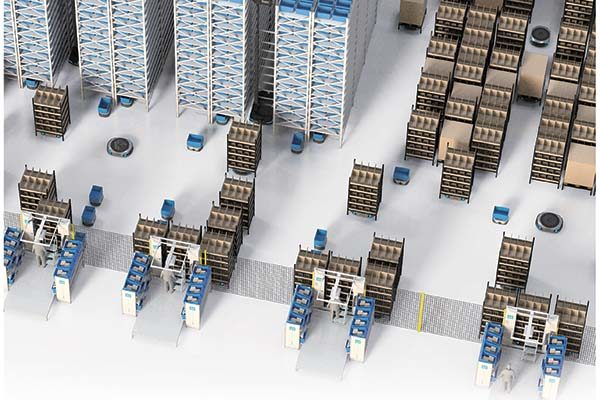Yes, your SMB can afford AMRs
Think robots are out of reach for your small or medium-sized business? It turns out there are models and pricing plans for nearly every budget—and experts at the ready to demystify the process.

If the calendar says November, then peak season is upon us. And as consumers ramp up their holiday spending, many warehouses and DCs will see a huge spike in volumes, with throughput running several times their normal daily levels.
Automation is frequently the solution to that challenge, and logistics technology firms in recent years have come up with an array of options. From speedy shuttles to capable robots, companies can outfit their facilities with tools that amplify the efforts of their human workers and other assets.
But to many small and medium-sized businesses (SMBs), those technical wonders may seem out of reach, with price tags or information technology (IT) requirements beyond their budgets. Sure, major retailers might have the infrastructure and sales volumes to justify an investment in goods-to-person robots or an automated storage and retrieval system (AS/RS). But smaller operations often assume they’ll just have to get by with temp workers and overtime pay.
However, several major players in the robotics market say that no longer holds true. Just ask the German logistics tech specialist Körber Supply Chain, which reports that fully half of its autonomous mobile robot (AMR) customers are SMBs. Körber offers technology and systems integration services, working with an array of robotics vendors, including the AMR developers Locus Robotics, Geek+, Balyo, and Fetch, as well as makers of 3D storage solutions such as Attabotics.
In fact, Körber says that supply chain tech developers have actually been designing software and other tools for SMBs for several years now, citing examples such as enterprise tech giant Oracle’s NetSuite enterprise resource planning (ERP) platform and Körber’s own Edge WMS warehouse management system for smaller users. What made these and similar offerings possible was the development of the cloud-based software-as-a-service (SaaS) model, which allows vendors to tailor their products (and pricing) to users of any size. Clients typically pay only for what they use via a monthly subscription fee, which eliminates the need for a large upfront capital investment.
Robot manufacturers are now applying a similar strategy to get AMRs into the hands of SMBs. Rather than requiring customers to purchase AMRs outright, many of them will supply robots under a subscription model called robotics-as-a-service (RaaS). One of the best known examples is Locus Robotics, which provides its bots on an RaaS basis. Among other advantages, that model offers a low cost of entry, manageable annual costs, and a return on investment (ROI) in under 12 months, according to John Santagate, vice president, robotics, for Körber Supply Chain Software.
DOING MORE WITH LESS
But even if warehouse robots are increasingly affordable, smaller users often worry about the installation process—specifically, the prospect of a long, drawn-out implementation. Many SMBs operate only a handful of DCs, so they can’t afford to shut down an entire facility to install the new technology.
To address those concerns, Santagate says his company encourages smaller clients to introduce robots at the same time they upgrade their warehouse management system (WMS), combining two upgrade cycles into one. He further notes that many of the newer warehouse management systems integrate so smoothly with warehouse robotics that the robots are often rolling up and down the aisles before the new software has booted up.
Another hurdle for SMBs looking to automate their operations are space and resource constraints. “They need maximum flexibility, velocity, throughput, and productivity,” says Santagate, “but it all has to fit inside a constrained environment.” In essence, he says, “they’re asking how to sustain their growth yet stay in the building for a few more years. So the answer is, they have to ‘do more with less.’”
It’s a similar story over at Fortna, the Atlanta-based systems integration firm. Like businesses everywhere, Fortna’s clients are struggling with systemic challenges like a nationwide labor shortage and a surge in online orders. In response, clients are looking to automate their operations, says Jeff Cashman, Fortna’s senior vice president of corporate development, “but they also say, ‘I don’t want to have to build a new building or install a mezzanine.’” Instead they want to make do with what they have by retrofitting their “brownfield”—or existing—facilities, he explains.
To ease the transition, Fortna often recommends a crawl-walk-run progression that calls for adding automation in stages. “For a lot of people, this [technology] is new, [and] it causes concern. So we have to de-risk it, and we have to demonstrate the value. Then the business can prove out the product and grow that solution, as opposed to having to be all-in. That’s especially important for an SMB,” Cashman says.
It’s also important for vendors to help each SMB define its specific needs, so it will have realistic expectations for the impact of robotics, he says. “It’s not about perfection; it’s about ‘good enough,’ because life changes,” Cashman says. “We have to be able to say ‘The design we have is good enough; it meets the business objectives,’ and not chase the ideal of perfection. The math has to work, no question; but perfection won’t always be the answer.”
ASK THE EXPERTS
In the meantime, there are efforts going on behind the scenes to help reduce the “fear factor” for SMBs—typically by demystifying robotics and simplifying the setup process. For instance, the tech giant Siemens recently launched a project to make industrial robotics more accessible to small and medium-sized manufacturers through a collaboration with Intrinsic. A subsidiary of Alphabet (the parent company of Google), Intrinsic is a robotics software and artificial intelligence (AI) company whose stated mission is to democratize access to robotics. The partners say they have teamed up to explore integrations between Intrinsic’s robotics software and Siemens Digital Industries’ portfolio of technologies for automating industrial production processes.
Likewise, the German nonprofit International Federation of Robotics (IFR) has built an online tool for small and mid-sized enterprises that are looking to automate. IFR says its Go4Robotics platform helps educate SMBs on how to get started with robotics, offering resources like articles, white papers, and e-books for nonexperts as well as a “five steps to success” checklist.
Educating everyone involved with automation upgrades is essential to the projects’ success, notes Körber’s Santagate. “You need alignment and buy-in with the user’s team, especially in the smallest operations, when the guy using the product might be the owner of the business,” he says. “While a large enterprise organization might have a project management office and a change management process in place, the SMB may not have those. But the challenges they’re facing are no different from an enterprise. They’re probably even more difficult because of their smaller scale. They have a lower threshold of success and risk, and they have to run a tighter operation.”Related Articles

Copyright ©2024. All Rights ReservedDesign, CMS, Hosting & Web Development :: ePublishing